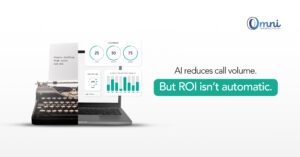For most companies, scheduling data lives in spreadsheets, dashboards, and workforce management tools. It’s treated as an operational necessity, something to make sure shifts are covered and service levels are met.
But what if we told you that scheduling data is one of the most overlooked strategic assets in CX today?
Used right, it can do more than just match agents to call volumes. It can unlock better forecasting, improve retention, and give leaders the kind of visibility that makes customer service proactive instead of reactive.
Why Scheduling Data Gets Ignored
There are two big reasons scheduling data is underutilized:
- It’s siloed. Often, scheduling sits with workforce management teams, disconnected from CX strategy.
- It’s seen as tactical. Leaders think of it as “coverage planning,” not as insight that can drive performance.
As a result, businesses miss opportunities to connect scheduling patterns with broader metrics like NPS, CSAT, or even revenue.
What Scheduling Data Really Tells You
Look deeper, and scheduling data answers questions that go far beyond “who’s on the phones?”
- Where are your peaks and valleys? Not just daily, but hourly and intraday patterns that reveal customer behavior.
- How does agent performance trend by shift? Some teams thrive in mornings, others in evenings, knowing this boosts productivity.
- What are your hidden bottlenecks? If volumes spike after a certain type of marketing campaign, you’ll see it in scheduling data before you see it in complaints.
- Where are you overpaying? If staffing stays flat while volume fluctuates, you’re covering hours of unproductive time.
In short: scheduling data doesn’t just measure operations. It reveals how well you’re matching customer demand to business resources.
From Data to Strategy
When paired with modern platforms, scheduling data becomes more than a planning tool, it’s a strategic lever. Imagine:
Real-time insights: Noticing a midday dip in demand and reassigning agents instantly.
Better forecasting: Using historical scheduling trends to predict surges tied to product launches or seasonal spikes.
Performance alignment: Matching the right agent skillsets to the times when they’ll have the biggest impact.
Employee satisfaction: Offering agents more flexible scheduling because you actually know when flexibility won’t hurt service levels.
How Platforms Like the Omniverse Elevate Scheduling
This is where technology like Omni’s Omniverse platform changes the game. Instead of static dashboards, Omniverse uses scheduling data dynamically, turning it into actionable intelligence.
That means:
- Staffing can adjust in 30-minute increments based on real-time demand.
- Leaders can see not just “who’s logged in,” but who’s adding value.
- CX strategy is guided by data that reflects both customer needs and agent performance.
Scheduling stops being reactive. It becomes the engine for smarter, more efficient, and more human CX operations.
Conclusion
Scheduling data has been hiding in plain sight for too long. It’s more than a back-office necessity. It’s a strategic asset that can transform how you serve customers, how you manage agents, and how you scale your business.
About Omni Interactions
Omni Interactions uses its proprietary Omniverse platform to turn scheduling data into strategy. With precision staffing and 30-minute flexibility, we ensure that every decision, from coverage to coaching, is guided by real-time insights that drive results.



